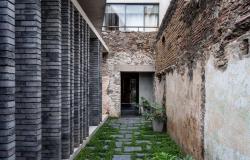


 + 30
+ 30
Share Share
EITHER
Clipboard “COPY” Copy

Description submitted by the project team. Given the need to design a campus for the so-called company “Alcaraván technological systems”, dedicated to the development of Software, hardware and other topics linked to technology, and with the information that, in the city of San Juan de los Morros , Guárico state in Venezuela, there were 4 buildings in a state of abandonment, the Federal Government Council, a Venezuelan government entity, decided to recondition 2 of these buildings, in order to house the headquarters building of the aforementioned company.


This happened, approximately in July 2020, one of the most critical moments due to the COVID-19 pandemic, circumstances that would decisively influence the moment of presenting, proposing and executing the project. The instructions were clear and precise: the project should be presented in an estimated time of a month and a half, the execution had to be divided into 2 stages; The first stage would have as its objective the adaptation of 2 existing buildings (called buildings “02” and “03”), in a maximum execution time of three months, and the second stage would have as its purpose the construction of a new building (called building “annex”), which would have a construction time of 8 months.


In both stages, the exterior areas, landscaping, etc. would also be built. The difficulty was conceived from the beginning, rather than as an obstacle, as an opportunity to demonstrate that, with limited resources and restrictions, it is possible to solve a design of these characteristics in a logical and efficient way. Hence, the materiality of the project posed a great challenge: that the materials were exclusively locally produced, and that simple inputs were used, seeking practicality, durability and warmth.


Programmatically, the construction of an office building was proposed, which should also contain other areas for collective uses, such as an auditorium, dining room, multipurpose rooms and a food production school. It was proposed that buildings “02” and “03” would contain the greatest number of the program requirements, offices, services and vertical circulations, understanding that these two buildings would be the first to be built, so the “annex” building would contain mostly collective use activities.


The complex would be developed on 4 levels: semi-basement level, ground floor level, level P1 and level P2. The vertical circulations and internal distribution of the complex were proposed by the two existing stairs in buildings “02 and 03” and a staircase that would connect with the semi-basement through the annex building. It should be reported that buildings “02” and “03” originally did not have elevators, a situation that was not modified as it is a low-rise building. In the case of the semi-basement level, this would contain activities for collective use, with independent access to the main access; the PB level would contain activities more for internal use of the institution; level P1 would be for the main pedestrian access hall which would be through an external staircase; This level would also contain uses that are related to all the activities of the complex.


Finally, level P2 would contain the most private use areas with exclusive access for the presidency and administrative areas and would be the only one that would not be connected to the rest through the annex building. It is important to note that buildings “02” and “03” were designed for social housing, which is why they have very particular characteristics, such as the structural axes spaced 3 meters apart and the heights between slabs of 2.50 meters. an issue that made them spatially very limited. This means that the intervention of those two buildings proposed the demolition of almost all the existing walls and understanding the spatial limitations, it was intended to leave the areas as clear as possible for their maximum use.

The columns and beams were stripped from the frieze, leaving the concrete exposed. The mechanical, sanitary and electrical installations in general of the complex would be installed in trays hanging from the ceiling, which meant that the cables, data racks, lighting and pipes would be visible, in addition to the practicality of doing it that way, The building internally would have a technological industrial atmosphere that goes very well with the new use.
It must be said that this complex is surrounded by impressive views, fields and mountains with very little intervention by man, where the natural monument Los morros de San Juan, located to the north, should be highlighted, so being able to appreciate them from the interior was an important part of the design. Specifically, that of the facades, had to function as a heat sink, in such a way that the building and the elements that compose it would collaborate to avoid unwanted thermal gains. The facades in buildings 02 and 03 were resolved with cement block parasols, rustic friezes and in the service areas openwork clay blocks.


The windows in the work areas are designed as elements of variable height and arranged interspersed according to the level and with a width of .50 centimeters, which allows that, together with the width of the window and parasol, the solar incidence can be be reduced to a minimum and have views to the outside in almost all work areas. The service areas for mechanical installations in general were located on the most unfavorable facades. The annex building is the connecting and unifying volume of the complex, it is developed with a square base plan of 15 x 15 meters; The structural axes are spaced 5.50 meters apart and 2.50 meter overhangs on all facades.

The levels between slabs are variable and range from 2.50 meters to 5.60 meters. This is developed on 2 levels and a semi-basement. The intention when structurally developing the building in this way, was to be able to have the freedom to solve differently, according to the solar incidence and the internal use of each level, maintaining homogeneity in the whole, with parasols built with concrete blocks, elements micro-perforated metal modulations, as well as that of cast concrete elements.

Finally, we wanted to challenge the obsolescence of the building from a stylistic point of view, obeying the use of strictly functional processes in an effective way, producing a dynamic and logical composition both in plan and elevation, avoiding “ornament” at all times. as an element to generate contemporaneity in the whole.





























